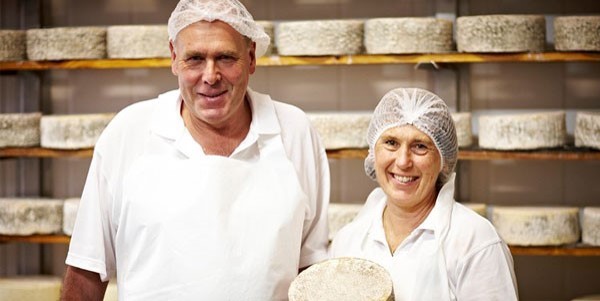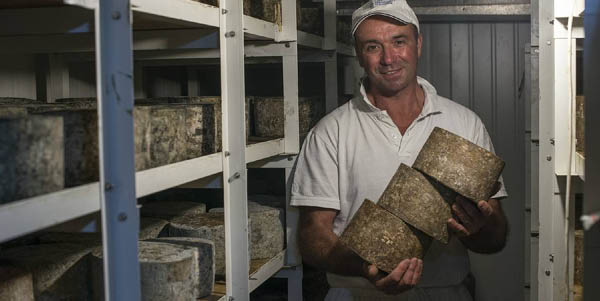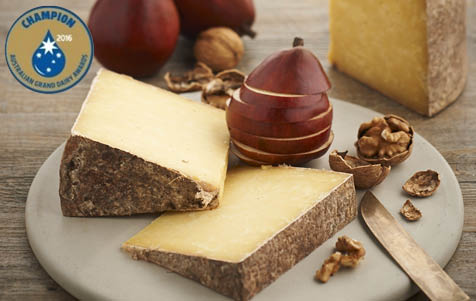
Australian Cheesemaker Profiles & Articles
Interview with Ueli Berger of King Island Dairy

He’s the son of a dairy farmer and the grandson of a cheesemaker, and hails from the Emmental region of Switzerland, so it’s fair to say that cheesemaking is in his blood. Meet Ueli Berger, Head Cheesemaker at King Island Dairy and winner of Grand Champion Cheese at the 2019 Australian Grand Dairy Awards and Champion Washed Rind at the 2020 Australian Grand Dairy Awards
Definitely the fact they are all hand made – for example, all of the cutting and stirring is done by hand. We don’t standardise the protein, but we do add fat when needed, so there is still some seasonal variation in the milk. We mostly make the cheddars in Spring, and late lactation milk makes better blue, for example.
But the big thing is the location – the terroir – with King Island in the middle of the Roaring 40s, which sprays minerals and salts over the land. The cows love it and it gives special milk. I can make exactly the same recipe in the factory in Burnie [on the Tasmanian mainland] but the cheese turns out differently.
Cheesemaking in Switzerland was all on a small scale – every village had its own cheese factory – so when I came to Burnie, I had never seen a factory of that size. It was mainly producing bulk cheddar – back then, even gouda was considered a specialty cheese! We knew it had to go forward here. It was exciting when we started making soft and blue cheeses in the 1980s. When King Island Dairy approached me to be their head cheesemaker in 1998, I really got to do my own thing. They said, “just start making new stuff,” so I did.
Because it has more to offer. A lot of brie and camembert is quite mild and mellow, but some people like a little bit more. It has the right balance between being very creamy but with an earthy, extra flavour. It’s great that peoples’ tastes have become more adventurous, and there is more we can do to go further with this style of cheese. Because it has more to offer. A lot of brie and camembert is quite mild and mellow, but some people like a little bit more. It has the right balance between being very creamy but with an earthy, extra flavour. It’s great that peoples’ tastes have become more adventurous, and there is more we can do to go further with this style of cheese.


My favourites are the Black Label Double Brie and Roaring 40s Blue, both of which won Champion at the 2017 Australian Grand Dairy Awards. I like to eat cheese with friends and a good laugh! That’s the best thing about making cheese – being able to enjoy it with people. King Island Dairy cheeses are distributed throughout Australia.
Interview with Barry Charlton of Berrys Creek Gourmet Cheese

When Barry Charlton set up Berrys Creek Gourmet Cheese in 2007 with his partner, Cheryl Hulls, he’d been a professional cheesemaker for more than 30 years. He’d made everything from cloth-rinded cheddar at the Drouin Butter Factory in the 1970’s, to the famous Triple Cream at Jindi in the 1990’s – but he’d never made a blue cheese. His blues are now regarded as the best in Australia.
I wanted to try something different. I have always been intrigued by the flavours in blue cheeses, and their variety and complexity. I was also ready for a different pace, having been head cheesemaker at Jindi for 10 years, with 50 staff and lots of stress. We did a few trials in the home kitchen and it went from there. I like a challenge! I wanted to try something different. I have always been intrigued by the flavours in blue cheeses, and their variety and complexity. I was also ready for a different pace, having been head cheesemaker at Jindi for 10 years, with 50 staff and lots of stress. We did a few trials in the home kitchen and it went from there. I like a challenge!
The quality of the milk is really important, and the fact that we’re able to know the results from the [protein and fat] analyses straight away. The cow’s milk varies a lot throughout the year so we adjust the cheesemaking to suit. Most of our milk comes from the Hutchinsons [a local dairy farming family] who have about 40% Jersey cows in the herd. I batch pasteurise, which is gentler on the milk, and monitor the progress of the curd by “hand feel”. I employ one other cheesemaker and a production assistant who both work under my close guidance, which means I have complete control over the cheesemaking process.

Tarwin Blue has earthy tones and more cowy notes, and is at its best when matured for 12 weeks. Bellingham finishes sweeter, and Moss Vale develops cheddary flavours at peak maturity. The buffalo milk used for Riverine Blue results in sweeter notes. Oak Blue is more time consuming to make and takes longer to mature. It has much bigger flavours than the others and is best at 5-6 months maturation, but can also start to break down at that age, so it’s a fine line. All of the cheeses are made using the same blue mould, but it’s the different starter cultures that produce such different results.
It’s one of our favourite cheeses. We love to enjoy it with some quality crackers and either a good red wine or a dark ale. These both complement the deep, strong flavours of the cheese.
Interview with Ian Fowler of Bay Of Fires Cheese

Could the secret to one of Australia’s best cheddars be a simple combination of rainfall and sunshine? Sonia Cousins, cheese expert and AGDA Judge, caught up with 13th generation cheesemaker Ian Fowler of Bay of Fires Cheese, who moved his family to Tasmania in 2009, to find out.
My wife Tracey bought me a big atlas about 12 years ago because she knew of my yearnings to start my own business. We just looked for somewhere with rainfall and sunshine and somewhere the grass would grow. And if the grass would grow, I could make cheese.
I started making the cheddar in December 2013, and we didn’t start selling that until early 2015. We don’t sell anything under 12 months of age.

One main difference is that I’m making cheese here with less equipment. It’s very much a hand-made product with the curd being cheddared by hand and salted by hand, and a lot of the equipment I’ve made myself. Also, in England the cows are housed for 6 months of the year, but in Tassie they are on pasture year-round.
The fact that it’s cloth-bound is the same as in England, and I also seal the cloths with lard. The whole approach is that which I was taught by my grandfather. I can really feel that tradition coming through now in the final product, and I’ve only really been selling the cheddar cheese for about a year. I’ve built up the cultures now on the pine boards, and they are now getting second cheeses put on them for maturation, whereas before the pine boards were new. The culture bases and the environment are all settling in and evolving.
My son is 14 now, and he’s the only male in the family line [including in England] – so, we’ll see... but he’s not allowed to take anything on until he knows how to do it!
Bay of Fires won Champion Cheddar at the 2016 Australian Grand Dairy Awards
Australian Cheesy Articles
The Big Cheese Debate: Drink Pairings, Density and What to Do With a Stinky Blue
Meet the Cheesemaker Churning Out Some of Australia’s Best Blues
Some of Australia's Best Cheese Comes from a Tiny Island
Recipe: Stinking Bishops’ Peppercorn Cheese Toastie
Recipe: Roaring Forties Grilled Cheese Toastie
Good Food: Five Delicious Dairy Daytrips